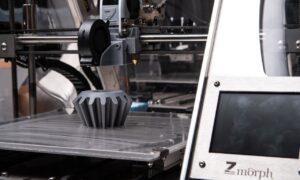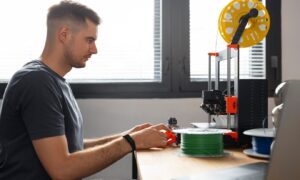Welcome to the future of manufacturing! In a world where sustainability has become more than just a buzzword, industries are striving to find innovative and efficient ways to produce goods without compromising our environment. Enter 3D printing, the game-changer that is turning traditional manufacturing on its head. With its ability to reduce waste, energy consumption, and production costs, while still delivering top-notch quality products – this futuristic technology is paving the way towards a sustainable future. So today, we delve into the realm of 3D printing and explore how it is revolutionizing manufacturing by placing sustainability and efficiency at its core. Buckle up for an exciting journey through innovation that will leave you inspired and hopeful for what lies ahead.
Introduction to 3D Printing
The average person today lives in a world of two dimensions. They are used to seeing things in a flat, layered way. This is the environment that most people are comfortable with and it is how they have been trained to think. But what if there was another way? What if things could be seen in three dimensions?
3D printing is a growing technology that is changing the way things are manufactured. With 3D printing, objects can be created from scratch using digital files. This process is called additive manufacturing, and it is revolutionizing the manufacturing industry.
There are many advantages to using 3D printing for manufacturing. One of the most important advantages is that it is much more efficient than traditional manufacturing methods. With traditional methods, objects are created by taking material away from a larger piece of material (subtractive manufacturing). This results in a lot of wasted material, as well as extra steps and processes that add time and cost to the final product.
With additive manufacturing, there is very little waste. Material is added only where it is needed, so there is very little waste material overall. In addition, 3D printing can be done much faster than traditional methods. Because there are no extra steps or processes involved, products can be made much faster with 3D printing.
Another important advantage of 3D printing is that it allows for more customization and personalization than traditional methods. With traditional methods, each product must be made the same way because the process cannot be adjusted. But 3D printing allows for a much higher degree of customization as the digital files used to create the object can be easily edited to suit the user’s exact needs.
3D printing is also more cost-efficient than traditional methods, as it results in a lower material cost and faster production time. This makes 3D printing an attractive option for businesses who need to produce large batches of customized products.
Overall, 3D printing is revolutionizing the manufacturing industry. By making products faster and with less waste, it is becoming an increasingly popular method for creating everything from prototypes to mass-produced objects. As this technology continues to evolve, we are sure to see even more amazing advancements in additive manufacturing.
The Benefits of 3D Printing for Sustainability & Efficiency
The benefits of 3D printing for sustainability and efficiency in manufacturing are many. Perhaps the most significant is that it drastically reduces the need for raw materials. In traditional manufacturing, a product is created by starting with a large block or sheet of material, which is then cut or shaped into the desired final form. 3D printing, on the other hand, builds products from the ground up using tiny droplets or filaments of material. This not only eliminates waste, but also allows for a much more efficient use of resources.
In addition to being more environmentally friendly, 3D printing is also significantly faster and more versatile than traditional manufacturing methods. While it may take weeks or even months to create a single product using traditional methods, a 3D printer can often create the same product in just hours or days. And because each product can be customized to meet the specific needs of the customer, there is very little wasted material involved in the process.
Overall, 3D printing offers a number of significant advantages over traditional manufacturing methods when it comes to sustainability and efficiency. By greatly reducing waste and resource consumption while simultaneously increasing speed and versatility, 3D printing is leading the way towards a more sustainable future for manufacturing.
How 3D Printing is streamlining the Manufacturing Process
The way we manufacture products is undergoing a shift, thanks in part to 3D printing. This technology is helping to streamline the manufacturing process, making it more sustainable and efficient.
3D printing is playing a big role in the move towards more sustainable manufacturing practices. It uses less energy than traditional manufacturing methods, and produces very little waste. In fact, some estimates suggest that 3D printing could reduce emissions from the manufacturing sector by up to 90%.
This technology is also helping to make the manufacturing process more efficient. Because 3D printers can create complex shapes without the need for tooling or molds, there is less waste and less time needed to produce products. This means that manufacturers can get their products to market faster and at a lower cost.
3D printing is still in its early days, but it has the potential to revolutionize the way we manufacture products. As we continue to find new ways to use this technology, we are likely to see even more sustainability and efficiency gains in the manufacturing sector.
Applications for 3D Printing in Different Sectors
The sector that is benefiting the most from 3D printing technology is the medical sector. Doctors and surgeons are able to print out organs and body parts that can be used for transplants or for practice. This has led to a huge increase in the number of people who are able to receive organ transplants. In addition, 3D printing is also being used to create prosthetic limbs and other assistive devices for people with disabilities.
The automotive industry is another area where 3D printing is having a big impact. Car companies are using 3D printers to create prototypes of new car models. This allows them to test out different designs before they commit to mass production. In addition, 3D printing is also being used to create custom car parts for people who have specific needs or wants.
The aerospace industry is also beginning to use 3D printing technology. Boeing has been using 3D printers to create engine parts for its new 787 Dreamliner planes. This has allowed Boeing to reduce the weight of the plane, which saves fuel and makes the plane more efficient. In addition, Airbus is using 3D printers to create luggage racks for its A350 planes. This helps to save space on the plane and makes it easier for passengers to find their luggage when they land.
3D printing is also having an impact in the construction industry. Architects and engineers are using 3D printers to create prototypes of buildings and bridges before they are built. This helps to identify any potential problems with the design before it’s too late. In addition, some construction companies are using 3D printers to create custom pieces of furniture and other objects for their clients.
Finally, there is a growing trend of people using 3D printing to create art and other objects for personal use. This has led to an explosion in the number of start-ups that are focused on providing different kinds of 3D printing services. As technology continues to improve and the cost of 3D printers decreases, more industries and consumers will be able to take advantage of this amazing technology.
Collaboration between Industry & Technology to Maximize Efficiency
The benefits of additive manufacturing (AM) are well documented, but the advantages it offers in sustainability and efficiency are often overlooked. In a traditional manufacturing process, material is removed from a larger block to create the desired shape. This results in a lot of waste as unused material is left behind. AM creates objects by depositing material layer by layer, meaning there is very little waste.
In terms of sustainability, AM also has a lower carbon footprint than traditional methods as less energy is required to heat and cool the build chamber. In fact, studies have shown that AM can use up to 50% less energy than conventional methods.
As manufacturers seek to become more sustainable and efficient, AM is an increasingly attractive option. The technology is also becoming more affordable as prices continue to fall. 3D printers are now available for under $500, making them accessible to a wider range of businesses and consumers.
Challenges of 3D Printing and Future Trends
The technological advances of 3D printing have incited a manufacturing renaissance in recent years. This has been especially apparent in the aerospace, automotive, and medical industries, where companies have been able to achieve greater levels of sustainability and efficiency through the use of 3D printing technology.
However, as with any new technology, there are challenges that need to be addressed in order to make 3D printing even more sustainable and efficient. One challenge is the cost of 3D printers and filaments. While the cost of 3D printers has come down significantly in recent years, it is still a major barrier for many companies who want to adopt this technology. In addition, filaments can be quite expensive, depending on the material being used.
Another challenge facing 3D printing is the issue of waste. Due to the nature of additive manufacturing, there is often a lot of wasted material when objects are printed. This waste can account for up to 30% of the total material used in some cases. However, there are ways to reduce this waste through careful design and planning ahead.
Despite these challenges, 3D printing offers a lot of promise for the future of sustainable and efficient manufacturing. As costs continue to fall and new applications are developed, it is likely that we will see even more widespread adoption of this technology in the years to come.
Conclusion
3D printing is quickly becoming essential for the manufacturing industry, improving sustainability and efficiency through its unique advantages. Already we are seeing 3D printing reducing waste, creating custom parts on-demand, streamlining production processes, and even introducing new materials that were never available before in traditional manufacturing processes. As the technology of 3D printing advances it will undoubtedly open up even more opportunities to increase sustainability within our industrialized world while also making production much more efficient and cost-effective for manufacturers everywhere.



































